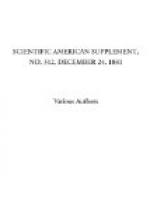With respect to steel, in 1831 the process in use was that of cementation, producing blistered steel, which was either piled and welded to make shear steel, or was broken into small pieces, melted in pots, and run into an ingot weighing only some 50 lb. or 60 lb. At that time steel was dealt in by the pound; nobody thought of steel in tons. In 1881, we are all aware that, by Sir Henry Bessemer’s well-known discovery, carried out by him with such persistent vigor, cast iron is, by the blowing process, converted into steel, and that of Dr. Siemens’ equally well-known process (now that, owing to his invention of the regenerative furnace, it is possible to obtain the necessary high temperature), steel is made upon the open hearth. We are, moreover, aware that, by both of these processes, steel is produced in quantities of many tons at a single operation, with the result that as instanced in the case of the North-Eastern rails, steel is a cheaper material than the wrought iron made by the puddling process. One cannot pass away from the steel manufacture without alluding to Sir Joseph Whitworth’s process of putting a pressure on the steel while in a tried state. By this means, the cavities which are frequently to be found in the ingot of a large size are, while the steel is fluid, rendered considerably smaller, and the steel is thereby rendered much more sound. In conclusion of my observations on the subject of iron and steel manufacture, I wish to call attention to the invention of Messrs. Thomas & Gilchrist, by which ores of iron, containing impurities that unfitted them to be used in the manufacture of steel, are now freed from these impurities, and are thus brought into use for steel-making purposes.
BRIDGES.
In the year 1831, bridges of cast iron existed; but no attempt had been made to employ wrought iron in girder bridges, although Telford had employed it in the Menai Suspension Bridge; but in 1881, the introduction of railways, and the improvement in iron manufactures, have demanded, and have rendered possible the execution of such bridges as the tubular one, spanning the Menai Straits, in span of 400 feet, and the Saltash, over the Tamar, with spans of 435 feet; while recent great improvements in the manufacture of steel have rendered




